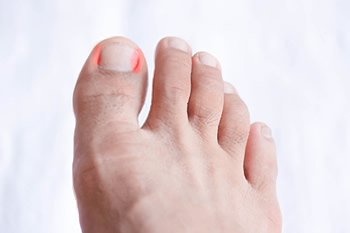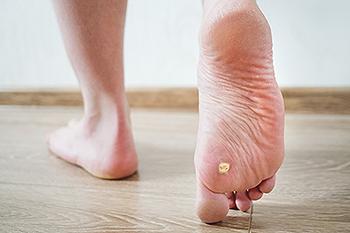Items filtered by date: October 2022
Causes of Ingrown Toenails

Recognizing an ingrown toenail can be tricky. One symptom many people ignore is the redness surrounding the big toe, which is often the first indication that an ingrown toenail has developed. Severe pain often follows, and the ingrown toenail can become infected. At this point, a podiatrist who can effectively treat this foot condition should be consulted. An ingrown toenail is defined as a nail that grows into the skin instead of over it. It may result from improperly trimming the toenails, sustaining a toe injury, or wearing shoes that are too tight. For mild cases, the foot may feel better when it is soaked in warm water. This may temporarily provide relief, but it may become worse if medical attention is not sought. If you have developed an ingrown toenail, it is strongly advised that you consult a podiatrist who can treat this condition.
Ingrown toenails may initially present themselves as a minor discomfort, but they may progress into an infection in the skin without proper treatment. For more information about ingrown toenails, contact one of our podiatrists of Toe-tal Family Footcare Associates. Our doctors can provide the care you need to keep you pain-free and on your feet.
Ingrown Toenails
Ingrown toenails are caused when the corner or side of a toenail grows into the soft flesh surrounding it. They often result in redness, swelling, pain, and in some cases, infection. This condition typically affects the big toe and may recur if it is not treated properly.
Causes
- Improper toenail trimming
- Genetics
- Improper shoe fitting
- Injury from pedicures or nail picking
- Abnormal gait
- Poor hygiene
You are more likely to develop an ingrown toenail if you are obese, have diabetes, arthritis, or have any fungal infection in your nails. Additionally, people who have foot or toe deformities are at a higher risk of developing an ingrown toenail.
Symptoms
Some symptoms of ingrown toenails are redness, swelling, and pain. In rare cases, there may be a yellowish drainage coming from the nail.
Treatment
Ignoring an ingrown toenail can have serious complications. Infections of the nail border can progress to a deeper soft-tissue infection, which can then turn into a bone infection. You should always speak with your podiatrist if you suspect you have an ingrown toenail, especially if you have diabetes or poor circulation.
If you have any questions, please feel free to contact our office located in Vista, CA and Las Vegas, NV . We offer the newest diagnostic and treatment technologies for all your foot care needs.
Which Ankle Bones Are Affected With an Ankle Fracture?

Broken bones in the ankle can occur due to an injury or a mishap. When there is a break in the ankle joint, the bones can separate into pieces. The tibia or fibula are often the most affected because they support the weight of the body. This type of fracture may cause severe discomfort while walking and may be difficult to do for several months. A broken ankle typically occurs from rolling or twisting the ankle beyond its normal range of motion, such as from unexpectedly stepping off of a curb. Common symptoms that many people experience with an ankle fracture can include bruising, and swelling, and it can be tender when touched. An X-ray is generally performed which is successful in determining the extent of the fracture and can then be treated accordingly. There are several methods to treat a broken ankle, consisting of wearing a walking boot, having a cast put on, and elevating the affected foot as often as possible. If you have endured a fractured ankle, it is strongly advised that you speak to a podiatrist who can effectively access the foot and offer the best treatment options for you.
Broken ankles need immediate treatment. If you are seeking treatment, contact one of our podiatrists from Toe-tal Family Footcare Associates. Our doctors can provide the care you need to keep you pain-free and on your feet.
Broken Ankles
A broken ankle is experienced when a person fractures their tibia or fibula in the lower leg and ankle area. Both of these bones are attached at the bottom of the leg and combine to form what we know to be our ankle.
When a physician is referring to a break of the ankle, he or she is usually referring to a break in the area where the tibia and fibula are joined to create our ankle joint. Ankles are more prone to fractures because the ankle is an area that suffers a lot of pressure and stress. There are some obvious signs when a person experiences a fractured ankle, and the following symptoms may be present.
Symptoms of a Fractured Ankle
- Excessive pain when the area is touched or when any pressure is placed on the ankle
- Swelling around the area
- Bruising of the area
- Area appears to be deformed
If you suspect an ankle fracture, it is recommended to seek treatment as soon as possible. The sooner you have your podiatrist diagnose the fracture, the quicker you’ll be on the way towards recovery.
If you have any questions, please feel free to contact our office located in Vista, CA and Las Vegas, NV . We offer the newest diagnostic and treatment technologies for all your foot care needs.
How Often Are Children’s Feet Measured?

Children grow at their own pace, and this is especially true of their feet. The feet can grow quickly, and it is beneficial to measure them every two months until they reach two years old. The next phase consists of measuring their feet every three months up to the age of five, followed by every six months between the ages of six and 11. The majority of babies are born with flat feet, and their feet are typically flexible and soft. There are benefits to children walking barefoot while they are indoors, and these can include sensing different types of surfaces, in addition to stretching their toes. When it is time to purchase their first pair of shoes, it is important for proper foot development to ensure that they fit correctly and have adequate arch support. Velcro closures or shoes that lace up are preferred, and this may allow for changes to the instep. If you have questions about what type of shoes your child will wear, or general concerns about children’s foot health, please consult with a podiatrist who can guide you in the right direction.
Making sure that your children maintain good foot health is very important as they grow. If you have any questions, contact one of our podiatrists of Toe-tal Family Footcare Associates. Our doctors can provide the care you need to keep you pain-free and on your feet.
Keeping Children's Feet Healthy
Having healthy feet during childhood can help prevent medical problems later in life, namely in the back and legs. As children grow, their feet require different types of care. Here are some things to consider...
Although babies do not walk yet, it is still very important to take care of their feet.
Avoid putting tight shoes or socks on his or her feet.
Allow the baby to stretch and kick his or her feet to feel comfortable.
As a toddler, kids are now on the move and begin to develop differently. At this age, toddlers are getting a feel for walking, so don’t be alarmed if your toddler is unsteady or ‘walks funny’.
As your child gets older, it is important to teach them how to take care of their feet.
Show them proper hygiene to prevent infections such as fungus.
Be watchful for any pain or injury.
Have all injuries checked by a doctor as soon as possible.
Comfortable, protective shoes should always be worn, especially at play.
If you have any questions please feel free to contact our office located in Vista, CA and Las Vegas, NV . We offer the newest diagnostic and treatment technologies for all your foot and ankle needs.
Why Do Plantar Warts Grow Inward?

Plantar warts grow inward on the sole of the foot as a result of the weight the feet endure from standing and walking throughout the day. A plantar wart is a specific strain of the human papillomavirus (HPV) and is contagious. It lives and thrives in warm and moist environments, which often include public swimming pools and locker rooms. Patients with a weakened immune system may be more susceptible to getting a plantar wart. This wart appears as a hardened area of the skin on the bottom of the foot and may have small black dots in the center. The warts can cause severe pain and discomfort, and prompt medical attention is often needed for relief. Part of the diagnosis process may consist of cutting away a small area of the wart and sending it to a lab for a biopsy. If you have developed a plantar wart, it is strongly advised that you confer with a podiatrist who can offer you the correct treatment options for relief.
Plantar warts can be very uncomfortable. If you need your feet checked, contact one of our podiatrists from Toe-tal Family Footcare Associates. Our doctors will assist you with all of your foot and ankle needs.
About Plantar Warts
Plantar warts are the result of HPV, or human papillomavirus, getting into open wounds on the feet. They are mostly found on the heels or balls of the feet.
While plantar warts are generally harmless, those experiencing excessive pain or those suffering from diabetes or a compromised immune system require immediate medical care. Plantar warts are easily diagnosed, usually through scraping off a bit of rough skin or by getting a biopsy.
Symptoms
- Lesions on the bottom of your feet, usually rough and grainy
- Hard or thick callused spots
- Wart seeds, which are small clotted blood vessels that look like little black spots
- Pain, discomfort, or tenderness of your feet when walking or standing
Treatment
- Freezing
- Electric tool removal
- Laser Treatment
- Topical Creams (prescription only)
- Over-the-counter medications
To help prevent developing plantar warts, avoid walking barefoot over abrasive surfaces that can cause cuts or wounds for HPV to get into. Avoiding direct contact with other warts, as well as not picking or rubbing existing warts, can help prevent the further spread of plantar warts. However, if you think you have developed plantar warts, speak to your podiatrist. He or she can diagnose the warts on your feet and recommend the appropriate treatment options.
If you have any questions please feel free to contact our office located in Vista, CA and Las Vegas, NV . We offer the newest diagnostic and treatment technologies for all your foot and ankle needs.
